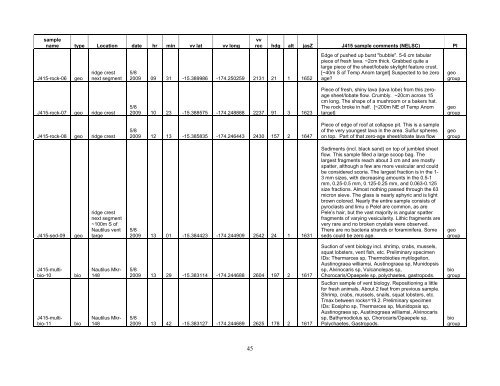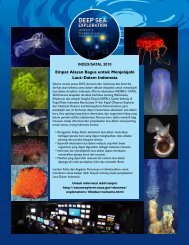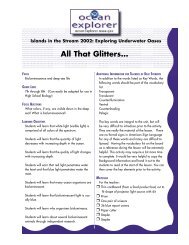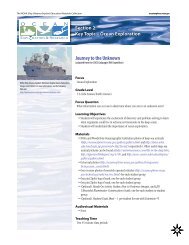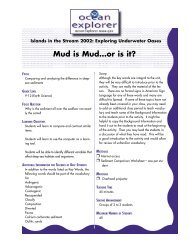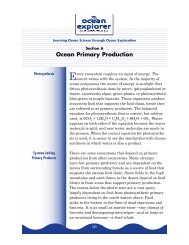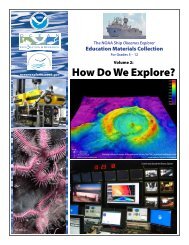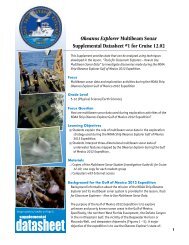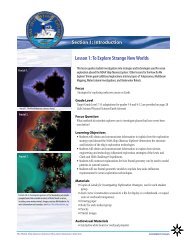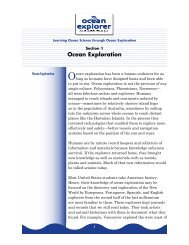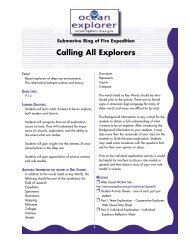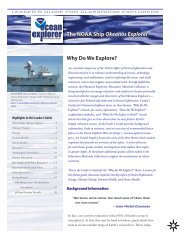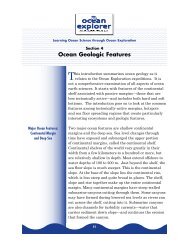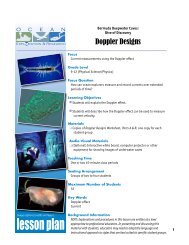Cruise Report (PDF, 4.8Mb) - NOAA, Ocean Explorer
Cruise Report (PDF, 4.8Mb) - NOAA, Ocean Explorer
Cruise Report (PDF, 4.8Mb) - NOAA, Ocean Explorer
Create successful ePaper yourself
Turn your PDF publications into a flip-book with our unique Google optimized e-Paper software.
sample<br />
name type Location date hr min vv lat vv long<br />
J415-rock-06 geo<br />
ridge crest<br />
next segment<br />
J415-rock-07 geo ridge crest<br />
J415-rock-08 geo ridge crest<br />
J415-sed-09 geo<br />
J415-multibio-10<br />
bio<br />
J415-multibio-11<br />
bio<br />
ridge crest<br />
next segment<br />
~100m S of<br />
Nautilus vent<br />
targe<br />
Nautilus Mkr-<br />
148<br />
Nautilus Mkr-<br />
148<br />
5/8<br />
2009 09 31 -15.389986 -174.250259 2131 21 1 1652<br />
5/8<br />
2009 10 23 -15.388575 -174.248888 2237 91 3 1623<br />
5/8<br />
2009 12 13 -15.385835 -174.246443 2430 157 2 1647<br />
5/8<br />
2009 13 01 -15.384423 -174.244909 2542 24 1 1631<br />
5/8<br />
2009 13 29 -15.383114 -174.244688 2604 197 2 1617<br />
5/8<br />
2009 13 42 -15.383127 -174.244689 2625 178 2 1617<br />
45<br />
vv<br />
rec hdg alt jasZ J415 sample comments (NELSC) PI<br />
Edge of pushed up burst "bubble". 5-6 cm tabular<br />
piece of fresh lava. ~2cm thick. Grabbed quite a<br />
large piece of the sheet/lobate skylight feature crust.<br />
[~40m S of Temp Anom target] Suspected to be zero<br />
age?<br />
Piece of fresh, shiny lava (lava lobe) from this zeroage<br />
sheet/lobate flow. Crumbly. ~20cm across 15<br />
cm long. The shape of a mushroom or a bakers hat.<br />
The rock broke in half. [~200m NE of Temp Anom<br />
target]<br />
Piece of edge of roof at collapse pit. This is a sample<br />
of the very youngest lava in the area. Sulfur spheres<br />
on top. Part of that zero-age sheet/lobate lava flow<br />
Sediments (incl. black sand) on top of jumbled sheet<br />
flow. This sample filled a large scoop bag. The<br />
largest fragments reach about 3 cm and are mostly<br />
spatter, although a few are more vesicular and could<br />
be considered scoria. The largest fraction is in the 1-<br />
3 mm sizes, with decreasing amounts in the 0.5-1<br />
mm, 0.25-0.5 mm, 0.125-0.25 mm, and 0.063-0.125<br />
size fractions. Almost nothing passed through the 63<br />
micron sieve. The glass is nearly aphyric and is light<br />
brown colored. Nearly the entire sample consists of<br />
pyroclasts and limu o Pelel are common, as are<br />
Pele’s hair, but the vast majority is angular spatter<br />
fragments of varying vesicularity. Lithic fragments are<br />
very rare and no broken crystals were observed.<br />
There are no bacteria strands or foraminifera. Some<br />
seds could be zero age.<br />
Suction of vent biology incl. shrimp, crabs, mussels,<br />
squat lobsters, vent fish, etc. Preliminary specimen<br />
IDs: Thermarces sp, Thermobioties mytilogeiton,<br />
Austinograea williamsi, Austinograea sp, Munidopsis<br />
sp, Alvinocaris sp, Vulcanolepas sp,<br />
Chorocaris/Opaepele sp, polychaetes, gastropods.<br />
Suction sample of vent biology. Repositioning a little<br />
for fresh animals. About 2 feet from previous sample.<br />
Shrimp, crabs, mussels, snails, squat lobsters, etc.<br />
Tmax between rocks=19.2. Preliminary specimen<br />
IDs: Eosipho sp, Thermarces sp, Munidopsis sp,<br />
Austinograea sp, Austinograea williamsi, Alvinocaris<br />
sp, Bathymodiolus sp, Chorocaris/Opaepele sp,<br />
Polychaetes, Gastropods.<br />
geo<br />
group<br />
geo<br />
group<br />
geo<br />
group<br />
geo<br />
group<br />
bio<br />
group<br />
bio<br />
group


